一、SpringBean的生命周期
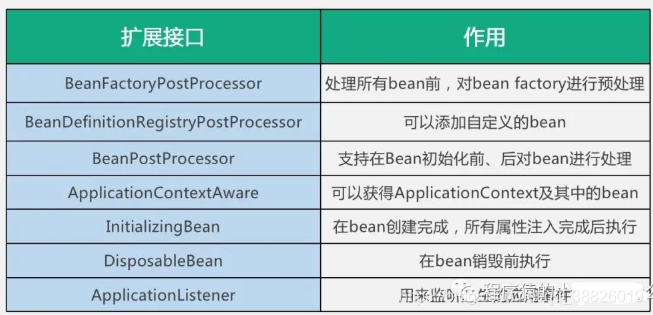
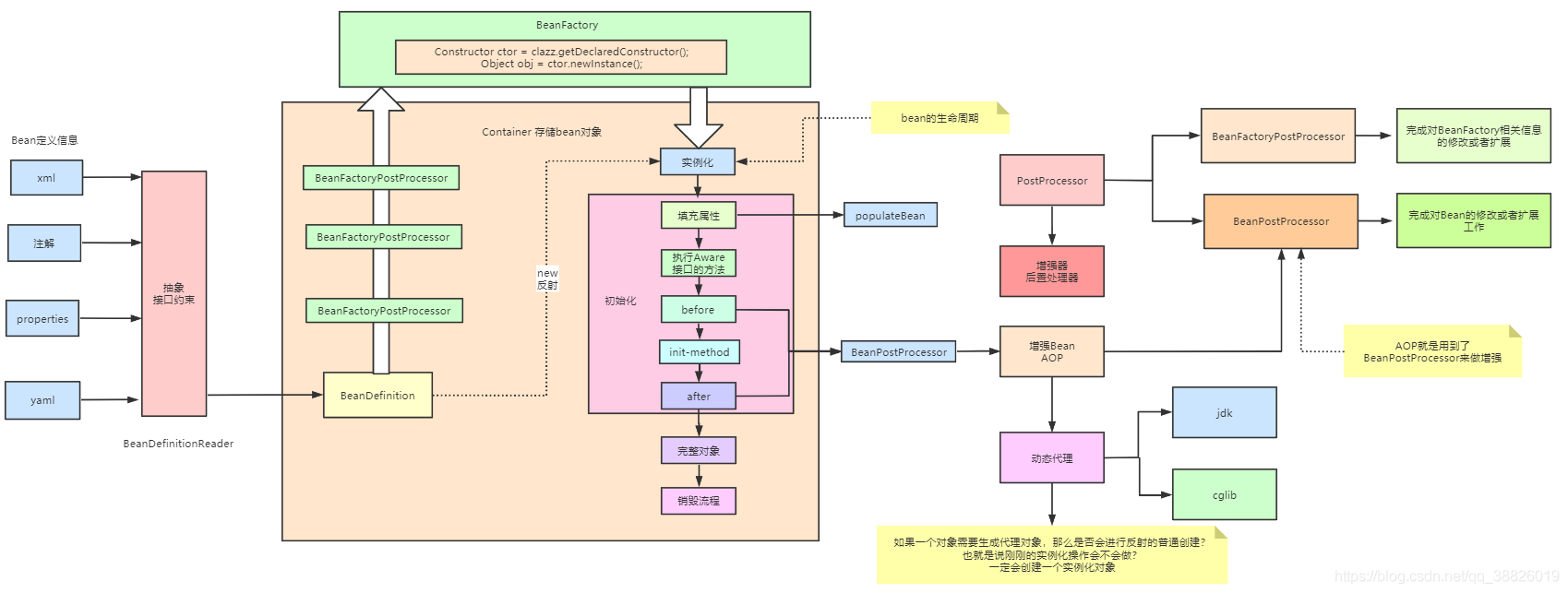
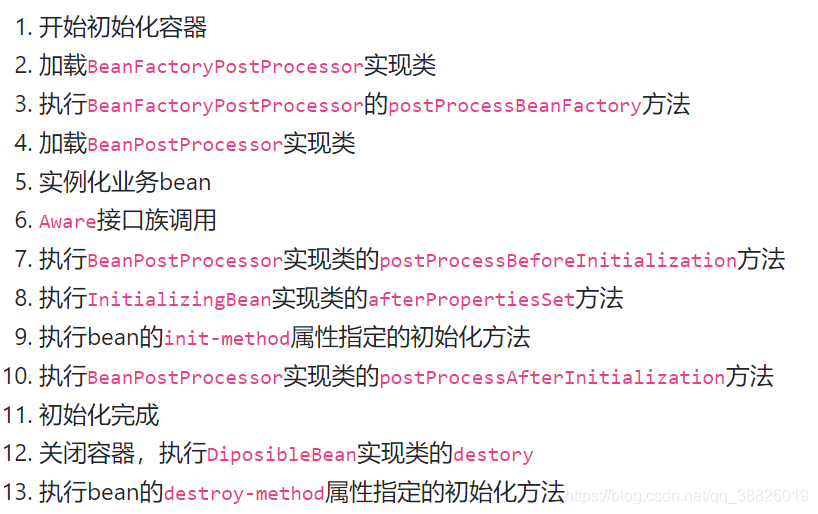
二、后置处理器postProcessor
一个是针对BeanDefinition的容器级别的后处理器 - BeanFactoryPostProcessor
一个是针对getBean操作获得的对象的后处理器 - BeanPostProcessor
两者的不同:
触发时机不同,前者BeanFactoryPostProcessor是在容器refresh方法中调用,而后者实际调用时机是在getBean方法获取对象时调用;
1.因触发时机不同导致二者处理的对象不同。
BeanFactoryPostProcessor处理的是解析完配置文件后注册在容器中的BeanDefinition,
而BeanPostProcessor处理的是通过反射生成的实例Bean;
2.接口样式不同,
BeanFactoryPostProcessor只有一个后处理方法,
而BeanPostProcessor有一个前置处理方法一个后置处理方法。
三、BeanPostProcessor
Spring主要提供了两类扩展点BeanPostProcessor和BeanFactoryPostProcessor。前者是操作bean的实例,后者使对bean的元数据定义进行扩展。
BeanPostProcessor提供对bean实例的操作扩展,在spring容器对bean实例化和设置依赖之后,其回调开始执行。BeanPostProcessor接口定义的两个方法,分别在bean的初始化方法(InitializingBean接口,或者init-method定义)执行的前后执行: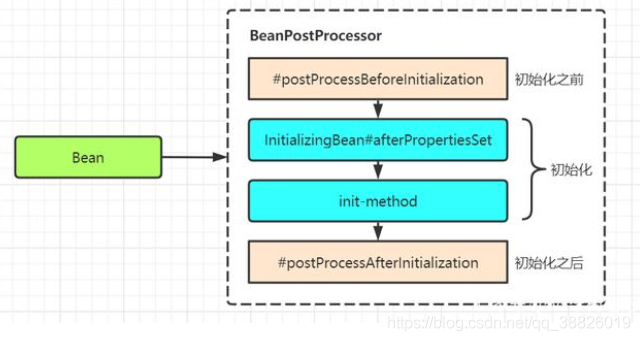
如果你想在Spring容器完成实例化,配置和初始化bean之后实现一些自定义逻辑,则可以插入一个或多个自定义BeanPostProcessor实现。这些实现成为后置处理器。
BeanPostProcessor接口包含两个回调方法。
当实现此接口类通过容器注册为后处理器时,由Spring容器实例的Bean,Spring容器会在bean 的init方法执行前回调postProcessBeforeInitialization方法,
然后会在bean初始化之后回调postProcessAfterInitialization方法。
后置处理器可以对这些Bean做任何自定义操作。一些Spring Aop 的基础实现类就是通过实现BeanPostProcessor从而提供代理包装逻辑 。
Spring容器能够自动检测任何实现了BeanPostProcessor接口的Bean。容器会自动将这些bean注册成后置处理器以便后续调用。
另外我们可以定义多个BeanPostProcessor,他们执行的顺序可以通过实现PriorityOrdered、Ordered接口来控制。
我们定义一个类实现了BeanPostProcessor,默认会对整个Spring容器中所有的bean进行处理,方法的参数:
1.每个Bean的实例
2.每个Bean的name 或者 id属性
实现 PriorityOrdered、Ordered,可以定义顺序
下面的示例演示如何在ApplicationContext中编写,注册和使用BeanPostProcessor实例(Spring AOP)的实现方式就是如下。
@Component public interface Person { void sayHello(); }
@Component("student")
public class StudentImpl implements Person {
private String name;
@Override
public void sayHello() {
System.out.println("Hello World, " + this.name);
}
@PostConstruct
public void init() {
this.name = "student";
}
@Override
public String toString() {
return "HelloWorldImpl{" +
"name='" + name + '\'' +
'}';
}
}
@Component("teacher")
public class TeacherImpl implements Person {
private String name;
@Override
public void sayHello() {
System.out.println("Hello World, "+this.name);
}
@PostConstruct
public void init(){
this.name="teacher";
}
@Override
public String toString() {
return "TeacherImpl{" +
"name='" + name + '\'' +
'}';
}
}
@Configuration @ComponentScan(value = "com.best") public class AppConfig { }
/** * 自定义HelloWorldBeanPostProcessor实现BeanPostProcessor接口 */ @Component public class HelloWorldBeanPostProcessor implements BeanPostProcessor { @Autowired private ApplicationContext applicationContext; // 直接返回实例化的bean,在bean初始化之前执行 @Override public Object postProcessBeforeInitialization(Object bean, String beanName) throws BeansException { System.out.println("postProcessBeforeInitialization: " + bean + ", " + beanName + ", " + applicationContext.getApplicationName()); return bean; } // 直接返回实例化的bean,在bean初始化之后执行 @Override public Object postProcessAfterInitialization(Object bean, String beanName) throws BeansException { System.out.println("postProcessAfterInitialization: " + bean + ", " + beanName + ", " + applicationContext.getApplicationName()); return Proxy.newProxyInstance(bean.getClass().getClassLoader(), bean.getClass().getInterfaces(), new InvocationHandler() { @Override public Object invoke(Object proxy, Method method, Object[] args) throws Throwable { System.out.println("BeanPostProcessor织入,Spring AOP实现原理"); return method.invoke(bean, args); } }); } }
执行入口:
public class Main { public static void main(String[] args) { AnnotationConfigApplicationContext applicationContext = new AnnotationConfigApplicationContext(AppConfig.class); Person student = (Person) applicationContext.getBean("student"); System.out.println(student.getClass().getName()); student.sayHello(); Person teacher = (Person) applicationContext.getBean("teacher"); System.out.println(teacher.getClass().getName()); teacher.sayHello(); } }
上面程序执行的结果如下:
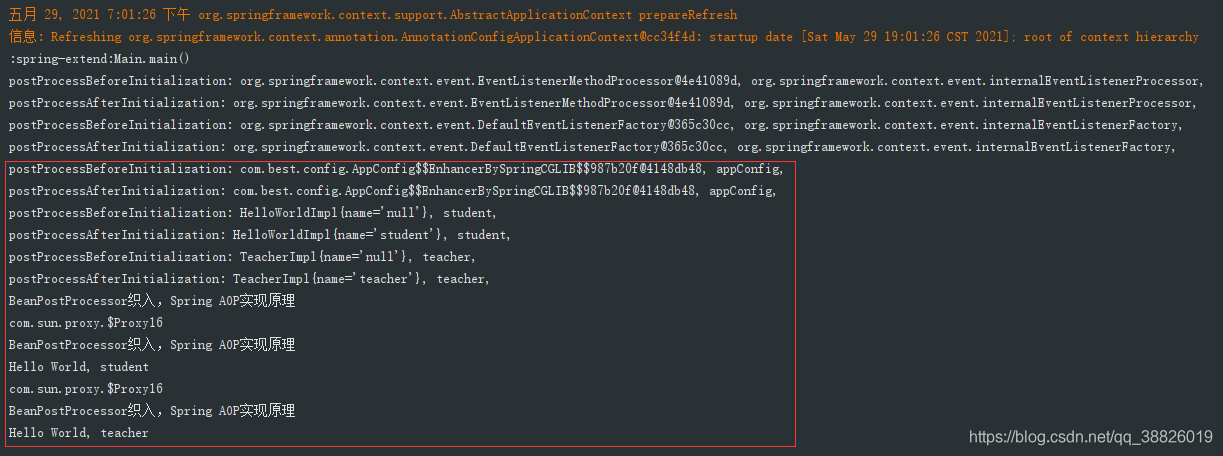
四、BeanFactoryPostProcessor
BeanFactory级别的处理,是针对整个Bean的工厂进行处理,这是Spring容器的另外一个扩展点,和BeanPostProcessor不同的地方在于,它是对beanDefiniton进行操作。
实现该接口,可以在spring的bean创建之前,修改bean的定义属性。
当调用BeanFactoryPostProcess 方法时,这时候bean还没有实例化,此时Bean刚被解析成 BeanDefinition对象。也就是说,Spring允许BeanFactoryPostProcessor在容器实例化任何其它bean之前读取配置元数据,并可以根据需要进行修改,
例如可以把bean的scope从singleton改为prototype,也可以把property的值给修改掉。可以同时配置多个BeanFactoryPostProcessor,并通过设置'order'属性或实现ordered接口来控制各个BeanFactoryPostProcessor的执行次序,
这些和BeanPostProcessor很类似,并且其启用方式和容器相关性也与之一致。
注意:BeanFactoryPostProcessor是在spring容器加载了bean的定义文件之后,在bean实例化之前执行的。
接口方法的入参是ConfigurrableListableBeanFactory,使用该参数,可以获取到相关bean的定义信息: BeanDefinition obj = arg0.getBeanDefinition("sumBean");
Spring内置实现了很多的BeanFactoryPostProcessor实现,例如:
org.springframework.beans.factory.config.PropertyPlaceholderConfigurer
org.springframework.beans.factory.config.PropertyOverrideConfigurer
org.springframework.beans.factory.config.CustomEditorConfigurer:用来注册自定义的属性编辑器。
public class TestBeanFactoryPostProcessor implements BeanFactoryPostProcessor { @Override public void postProcessBeanFactory(ConfigurableListableBeanFactory beanFactory) throws BeansException { System.out.println(" IOC 容器调用了 YjBeanFactoryPostProcessor 的 postProcessBeanFactory方法"); for(String name:beanFactory.getBeanDefinitionNames()) { if("yjLog".equals(name)) { BeanDefinition beanDefinition = beanFactory.getBeanDefinition(name); //beanDefinition.setLazyInit(true); } } } }
下面示例,如何通过BeanFactoryPostProcessor动态注册Bean进去。
@Component public class User { private Integer id; private String name; public Integer getId() { return id; } public void setId(Integer id) { this.id = id; } public String getName() { return name; } public void setName(String name) { this.name = name; } @Override public String toString() { return "User{" + "id=" + id + ", name='" + name + '\'' + '}'; } }
@Configuration @ComponentScan(value = "com.best") public class AppConfig { }
@Component public class HelloWorldBeanFactoryPostProcessor implements BeanFactoryPostProcessor { // 实现BeanFactoryPostProcessor,在spring的bean创建之前,对beanDefinition进行操作,修改bean的定义属性 @Override public void postProcessBeanFactory(ConfigurableListableBeanFactory configurableListableBeanFactory) throws BeansException { DefaultListableBeanFactory defaultListableBeanFactory = (DefaultListableBeanFactory) configurableListableBeanFactory; BeanDefinitionBuilder beanDefinitionBuilder = BeanDefinitionBuilder.genericBeanDefinition(User.class); beanDefinitionBuilder.addPropertyValue("id", 1); beanDefinitionBuilder.addPropertyValue("name", "jak"); defaultListableBeanFactory.registerBeanDefinition("user", beanDefinitionBuilder.getBeanDefinition()); } }
程序入口,获取User并输出。
public class Main { public static void main(String[] args) { AnnotationConfigApplicationContext applicationContext = new AnnotationConfigApplicationContext(AppConfig.class); User user = (User) applicationContext.getBean("user"); System.out.println(user.toString()); } }
程序输出结果,如下:

五、BeanDefinitionRegistryPostProcessor
这个接口继承了BeanFactoryPostProcessor. 从名字上来看, 这个接口是BeanDefinitionRegistry的后处理器,
我们先介绍下BeanDefinitionRegistry.
BeanDefinitionRegistry是用来注册BeanDefinition的.
BeanDefinition就是Bean的配置元数据或Bean的描述信息, 比如Bean的属性值, 构造方法的参数值等. 上面的BeanFactory的BeanDefinition也是由它注册的.
BeanDefinitionRegistryPostProcessor是BeanFactoryPostProcessor的扩展, 允许在BeanFactoryPostProcessor被调用之前对BeanDefinition做一些操作, 尤其是它可以注册BeanFactoryPostProcessor的BeanDefinition.
它提供了一个方法postProcessBeanDefinitionRegistry(), 这个方法被调用的时候, 所有的BeanDefinition已经被加载了, 但是所有的Bean还没被创建.
注意:
所有的Bean生成都有个顺序: 定义 --> 创建 --> 初始化.
BeanDefinitionRegistryPostProcessor的postProcessBeanDefinitionRegistry方法在Bean被定义但还没被创建的时候执行.
BeanFactoryPostProcessor的postProcessBeanFactory方法在Bean被创建但还没被初始化的时候执行
@Component public class BestBeanDefinitionRegistryPostProcessor implements BeanDefinitionRegistryPostProcessor { //该方法用来注册更多的bean到spring容器中 @Override public void postProcessBeanDefinitionRegistry(BeanDefinitionRegistry registry) throws BeansException { System.out.println("BestBeanDefinitionRegistryPostProcessor的postProcessBeanDefinitionRegistry方法"); //框架自己的 BeanDefiniton Count System.out.println("bean定义的数据量:" + registry.getBeanDefinitionCount()); RootBeanDefinition rootBeanDefinition = new RootBeanDefinition(BestBeanDefinitionRegistryPostProcessor.class); registry.registerBeanDefinition("bestBeanDefinitionRegistryPostProcessor", rootBeanDefinition); } // 继承自BeanFactoryPostProcessor的方法 主要用来对bean定义做一些改变 @Override public void postProcessBeanFactory(ConfigurableListableBeanFactory beanFactory) throws BeansException { System.out.println("BestBeanDefinitionRegistryPostProcessor的postProcessBeanFactory方法"); System.out.println("bean定义的数据量:" + beanFactory.getBeanDefinitionCount()); } }
public class Main { public static void main(String[] args) { AnnotationConfigApplicationContext applicationContext = new AnnotationConfigApplicationContext(AppConfig.class); BestBeanDefinitionRegistryPostProcessor bestBeanDefinitionRegistryPostProcessor = (BestBeanDefinitionRegistryPostProcessor) applicationContext.getBean("bestBeanDefinitionRegistryPostProcessor"); System.out.println(bestBeanDefinitionRegistryPostProcessor.getClass().getCanonicalName()); } }
运行结果:

六、InitializingBean和DisposableBean
Spring 中定义了 3 种自定义初始化和销毁方法。
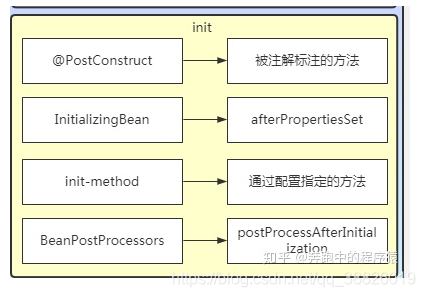
1.过@Bean指定init-method和destroy-method属性
2.Bean实现InitializingBean(定义初始化逻辑),DisposableBean(定义销毁逻辑);
3.@PostConstruct:在bean创建完成并且属性赋值完成;来执行初始化方法
Spring bean 通过实现 InitializingBean ,DisposableBean 接口实现初始化方法和销毁前操作
这个接口有一个方法:afterPropertiesSet, 该方法在所有的属性都被赋值后调用. 属性被赋值是在初始化的时候做的, 与BeanPostProcessor结合来看,
afterPropertiesSet方法将在postProcessBeforeInitialization和postProcessAfterInitialization之间被调用.
@Component public class Student implements InitializingBean, DisposableBean { @Override public void destroy() throws Exception { System.out.println("DisposableBean destroy"); } @Override public void afterPropertiesSet() throws Exception { System.out.println("InitializingBean afterPropertiesSet"); } }
@Configuration @ComponentScan(value = "com.best") public class AppConfig { }
public class Test { public static void main(String[] args) { /** * 1.把类扫描出来--扫描以后干了什么事情 * 2.把bean实例化 */ AnnotationConfigApplicationContext applicationContext = new AnnotationConfigApplicationContext(AppConfig.class); Student student = applicationContext.getBean(Student.class); System.out.println(student.getClass().getName()); applicationContext.close(); } }
运行结果:

七、 Aware接口
Spring中提供了各种Aware接口,如果检测到一个bean实现了Aware接口,则能在bean中获取相应的Spring资源;
如果某个对象实现了某个Aware接口,比如需要依赖Spring的上下文容器(ApplicationContext),则可以实现ApplicationContextAware接口。
Spring在Bean进行初始化(注意与实例化的区别)之前,会将依赖的ApplicationContext对象通过调用ApplicationContextAware#setApplicationContext注入。
Spring 提供的Aware接口如下:
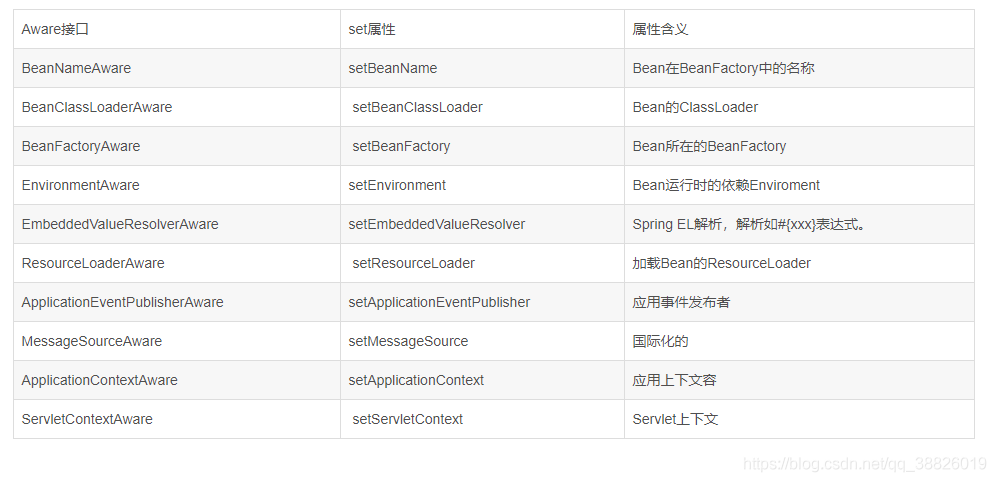
那么这些Aware接口在源码中是什么时候调用的呢?
AbstractAutowireCapableBeanFactory#invokeAwareMethods
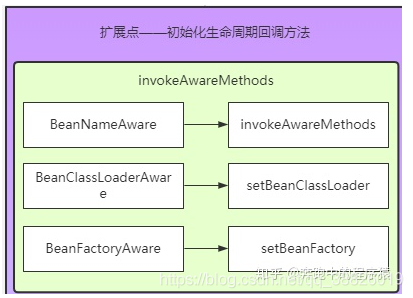
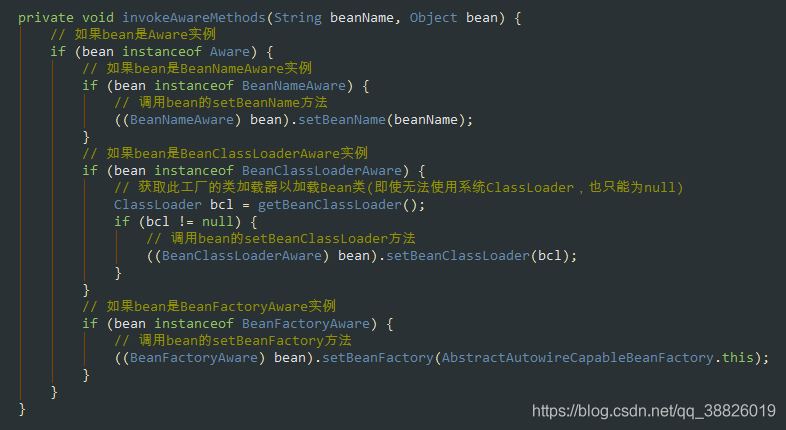
其他的Aware接口呢?通过 ApplicationContextAwareProcessor
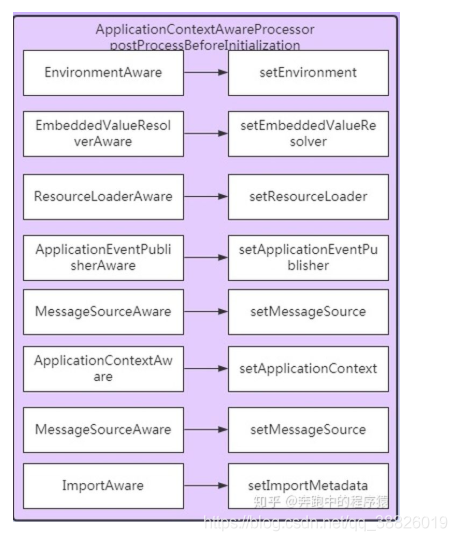

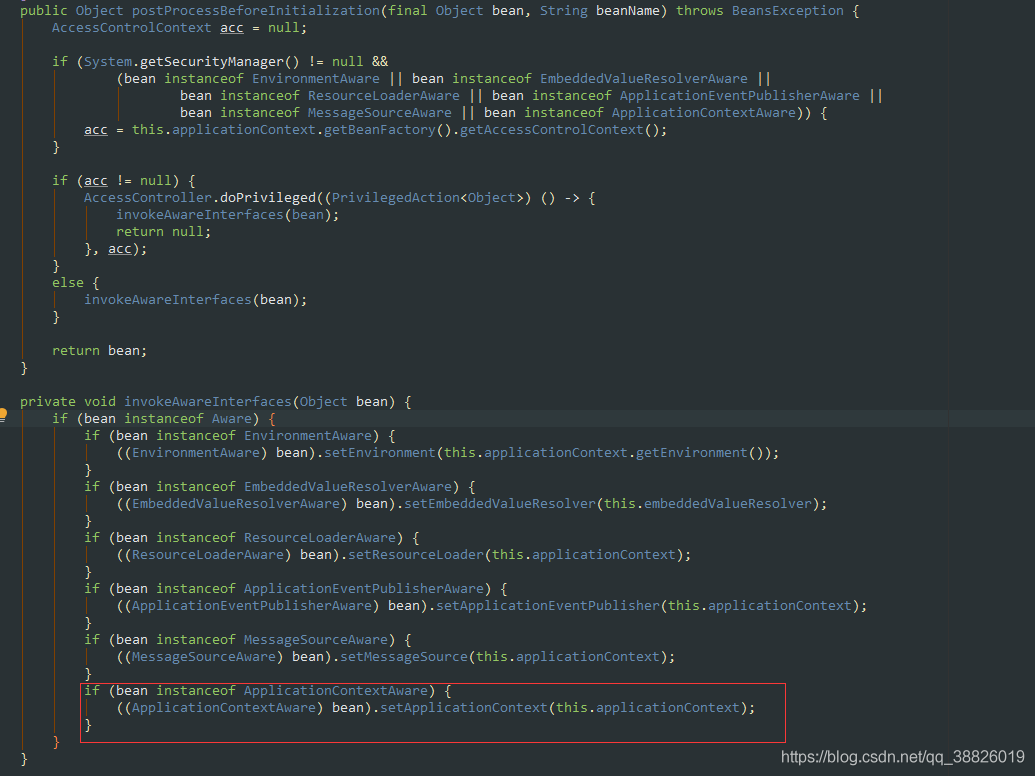
应用示例
@Component public class BestApplicationContextAware implements ApplicationContextAware { ApplicationContext applicationContext; @Override public void setApplicationContext(ApplicationContext applicationContext) throws BeansException { this.applicationContext = applicationContext; String[] beanDefinitionNames = this.applicationContext.getBeanDefinitionNames(); System.out.println(Arrays.toString(beanDefinitionNames)); } }
public class Main { public static void main(String[] args) { AnnotationConfigApplicationContext applicationContext = new AnnotationConfigApplicationContext(AppConfig.class); BestApplicationContextAware bestApplicationContextAware = (BestApplicationContextAware) applicationContext.getBean("bestApplicationContextAware"); System.out.println(bestApplicationContextAware.getClass().getCanonicalName()); } }
运行结果:

八、FactoryBean
一般情况下,Spring通过反射机制利用bean的class属性指定实现类来实例化bean 。 在某些情况下,实例化bean过程比较复杂,如果按照传统的方式,则需要在bean中提供大量的配置信息,配置方式的灵活性是受限的,这时采用编码的方式可能会得到一个简单的方案。 Spring为此提供了一个org.Springframework.bean.factory.FactoryBean的工厂类接口,用户可以通过实现该接口定制实例化bean的逻辑。 (后面Spring又提供了@Configration和@Bean这种方式,一定程度上可以替代FactoryBean)

public interface FactoryBean<T> { @Nullable T getObject() throws Exception; @Nullable Class<?> getObjectType(); default boolean isSingleton() { return true; } }
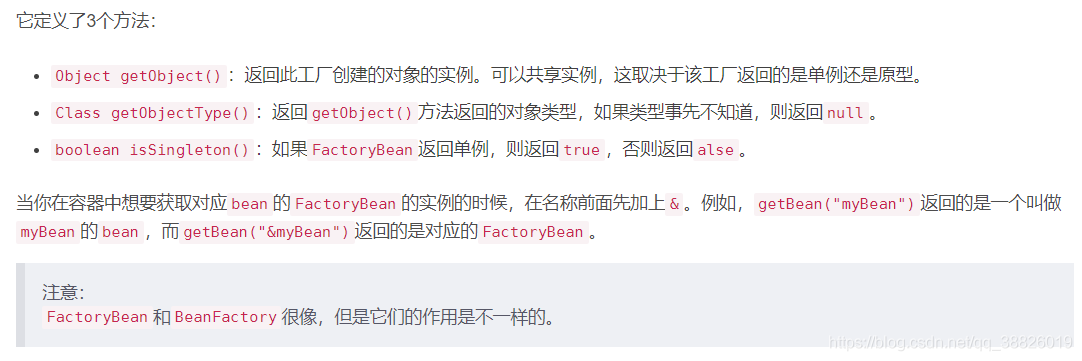
FactoryBean和BeanFactory的区别
BeanFactory

FactoryBean

应用场景

@Component public class BestFactoryBean implements FactoryBean<User> { private String userInfo; public User getObject() throws Exception { User User = new User(); String[] infos = userInfo.split(","); User.setId(Integer.parseInt(infos[0])); User.setName(infos[1]); return User; } public Class<User> getObjectType() { return User.class; } public boolean isSingleton() { return false; } public String getUserInfo() { return this.userInfo; } // 接受逗号分割符设置属性信息 public void setUserInfo(String userInfo) { this.userInfo = userInfo; } }
九、ApplicationListener
这跟Servlet中的监听器一样, 采用了观察者模式. 监听器往往都是监听某些事件源,
下面是配合ApplicationContextAware一起使用的例子.
我们定义一个事件, 在实现了ApplicationContextAware的Bean中触发事件, 在实现了ApplicationListener的类中对事件做出反应
// 自定义事件 public class RumenEvent extends ApplicationEvent { public RumenEvent(Object source) { super(source); } } // 自定义 Bean 实现 ApplicationContextAware 接口 @Component public class RumenzBean implements ApplicationContextAware { private ApplicationContext applicationContext; private String name; public void setApplicationContext(ApplicationContext context) { this.applicationContext = context; } // 当调用 setName 时, 触发事件 public void setName(String name) { this.name = name; applicationContext.publishEvent(new RumenEvent(this)); // 这行代码执行完会立即被监听到 } public String getName() { return name; } } // 自定义监听器, 监听上面的事件 @Component public class MyApplicationListener implements ApplicationListener { @Override public void onApplicationEvent(ApplicationEvent event) { if (event instanceof RumenEvent) { System.out.println(((RumenzBean)event.getSource()).getName()); } } }
参考博客:Spring常用扩展点
原文地址:http://www.cnblogs.com/qiulong/p/16929503.html
